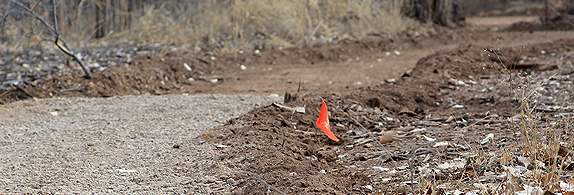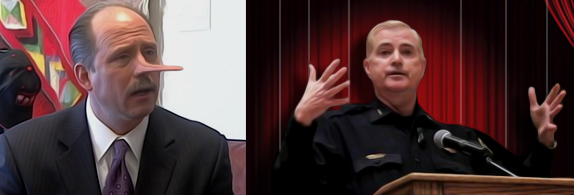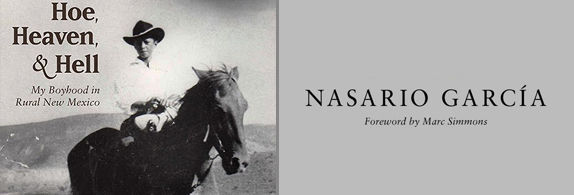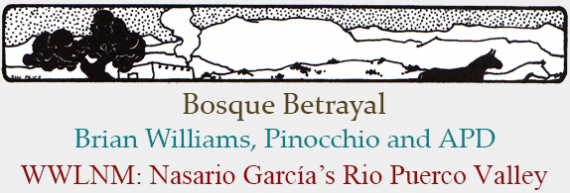Bosque Betrayal

Don’t ever try to deal in good faith with Albuquerque Mayor Richard Berry again. That’s the lesson to be learned from the recent bulldozing of a path through the sensitive habitat of the Rio Grande Bosque—done during negotiations with environmental organizations and individuals representing decades of dedicated work to preserve the Bosque as a living semi-wild habitat.
Mayor Berry’s action can call into question all agreements and negotiations that the City is a part of, including those with the U.S. Department of Justice over unconstitutional use of lethal and non-lethal force by the Albuquerque Police Department. It’s one more betrayal in a history of such actions over many administrations that have undermined the validity of citizens participating in any kind of planning process. It’s one of the chief causes of voter apathy and the chronic disengagement of many honorable civic minded people from urban politics, which used to be seen as a social duty here.
The City’s action in the Bosque is an unforgivable breach of public trust. Folks opposed to Berry’s plan to turn the Bosque into a highly developed urban park thought they were on the brink of a workable compromise with the City—including ways to give disabled people better access to the Bosque. But apparently Mayor Berry had different, and secret, plans.
Richard Barish of the Bosque Action Team wrote in a chilling piece in the Mercury last week that the mayor’s plowing up of the Bosque was an “extraordinary display of disdain for the wishes of the public he nominally represents….Although not literally done in the dead of night, the Mayor could not have been more secretive.” Barish was a guest on Insight New Mexico last year and explained the overwhelming opposition to the mayor’s plans for the Bosque. You can see that interview here.
Public betrayals by politicians and by legal and fiduciary processes, as well as by corporate fiat, undermine citizen involvement in local politics, the bedrock of local self-government.
This bulldozing of the Bosque trail, right through sensitive riparian habitat reminds me of the night Mayor Marty Chavez ordered the removal of a cherished old Cottonwood Tree on Rio Grande Blvd., a symbol of the long citizen resistance to the habitat-destroying creation of the Montaño Road Bridge. Or the decision to bulldoze a road through the West Mesa petroglyphs. Or the government decision to demolish dozens of historic buildings downtown during urban renewal to make way for huge, and expensive, new junk architecture.
I’m reminded, as well, of the time in the mid-1970s when Mayor Harry Kinney wanted the City Council to change the definition of open space so developers could build around the West Mesa volcanoes. Kinney’s plan horrified the hundreds of citizens who had worked for years to create the city’s exemplary open space program. They saw the mayor’s idea to define open space as one house on every 40 acres as a betrayal of the whole concept of open spaces untrammeled by urban forms and infrastructure. The City Council, thank heavens, didn’t agree with Mayor Kinney and Albuquerque evolved into a city with one of the greatest open space holdings of any city in the country.
What Mayor Berry has done has violated the spirit of open space in the Bosque, forty some years after Kinney tried. And the Bosque, from Central to the I-40 bridge, will never recover from this. It’s a permanent scar unless the City undertakes expensive, and highly sensitive, remediation. The Bosque from 1-40 to Alameda remains, as of this writing, as yet un-bulldozed. And it must remain that way at the risk of losing everything so many of us worked so long to preserve.
This bulldozing of a six-foot wide trail through the wild habitat of the Bosque is similar in its grossness to a moment in history that sealed the fate of downtown in the early l970s. The first was the demolition of Albuquerque’s trademark train station hotel, Fred Harvey’s Alvarado, in l970. It came as an almost complete surprise to everyone. The Atchison, Topeka, and Santa Fe Railroad decided the Alvarado had become a financial burden and just tore it down, with almost no warning and no official opposition. And that was that. An icon of the city vanished. The next year saw the Franciscan Hotel, the great architectural homage to Taos Pueblo at Sixth and Central NW, torn down in less than a week with no warning and no opposition possible. One day it was intact, the next it was in tatters. And to this day no one I know of is completely sure why. Downtown lost two anchors and its core identity in less than a year.
The wild land of more than a mile of the Bosque, its core identity, was scarred and violated in what amounts to a weekend.
Citizen participation in the planning process in Albuquerque has become a farce. Are the courts our only remedy? The city doesn’t seem to mind paying out millions and millions of dollars in civil suits as it has done over police brutality and other police violations of civil rights, some $24 million by my count since 2010. All we really have left is elections, and perseverance. City voters actually elected Mayor Berry in a landslide. But I am certain people who love the Bosque will have the persistence to fight the good fight, and even win now and then.
A small victory was achieved late last week when the City Council voted in favor of a bill by Councilor Ike Benton, who represents District Two in the Valley, to stop bulldozing in the Bosque. Mayor Berry will probably veto the bill as the city has not, as of this writing, stopped working on the trail.
To win big you have to win at the polls. Some people really do think that it doesn’t matter who gets elected, that “they’re all the same.” But that’s hooey. No one is “the same” as someone else. The human creature isn’t like that. Would this betrayal in the Bosque have happened if Albuquerque’s voters had elected Pete Dinelli mayor two years ago? My intuition says absolutely not.
Brian Williams, Pinocchio, and APD

The Albuquerque Police Department got caught in a big Brian Williams-like fabrication about the condition of Officer Jeremy Dear’s lapel camera during his pursuit and killing of l9-year-old Mary Hawkes in April last year.
We know Dear’s camera didn’t record the fatal encounter. At the time, APD chief Gordon Eden waxed on about how the camera might have been faulty and how APD was going to send it back to the manufacturer, Taser Inc., to see if they could get any images or tell what really happened. These prevarications, mostly from Eden, went on and on with no closure for months.
But according to a taping of an interview taken by APD investigators two days after the shooting, Officer Dear admitted that his camera was unplugged when he shot Mary Hawkes 3 times.
The Albuquerque Journal uncovered this story and produced a strong editorial with the headline “APD camera stories seem unplugged from the truth.”
They sure do. They certainly wouldn’t pass the Pinocchio test that NBC news anchor Brian Williams recently failed for telling tall tales about some of his journalistic derring-do.
If the Mary Hawkes killing wasn’t such an abysmal tragedy, the upper echelons of APD, the Mayor, and Chief Eden should have been laughed off the public stage for over-enhanced Pinocchio-ism too. The nose grows longer as the lies grow bigger.
Dear was fired by APD for being untruthful and insubordinate many months after the Hawkes shooting. But APD still wove its web of falsehoods about his unplugged camera until the Journal uncovered the truth through documents gained recently from an Inspection of a Public Records Act request.
Does APD and City Hall have a chronic truth telling disorder? Are they incapable of a straight answer? Williams was humiliated, ridiculed, and suspended from his job for a proclivity, perhaps an innocent one, to embellish. There’ll be no consequences in Albuquerque for APD or the Mayor stringing the public along for months about Dear’s camera. Nothing will happen. Nada.
But, of course, there rarely are any consequences for police misconduct here, or for politicians and their appointees shamelessly slinging bull all over the public and the media. Lies don’t count in Albuquerque, even though they stink to high heaven. Pinocchio’s nose always stays nicely extended here, no matter how much nose-holding citizens have to do to put up with the unbearable smell that, lately, never seems to go away.
Why We Love New Mexico: Nasario García’s Rio Puerco Valley

Nasario García, New Mexico’s great folklorist, historian, poet and author, continues to amaze his readers with his seemingly endless stream of wonderful books. His latest is Hoe, Heaven, and Hell: My Boyhood in Rural New Mexico, published by UNM Press this year. It chronicles his early days along the Rio Puerco near Cabezon in a village called Ojo del Padre and in the countryside around it. A brutal drought forced Nasario’s family and many others to move to Albuquerque in l945, the Garcías settling in Santa Barbara (Martineztown). But Nasario describes his boyhood along the Puerco in such a joyous and contented way that you can’t help but wish that everyone could have been fortified in their early years by a family of such warmth and closeness and affirming values.
Ojo del Padre is known today as Guadalupe. You can see signs for it on the NM 550 on the road to Cuba. I first saw it and its neighboring village Casa Salazar in l962 after a harrowing drive down some of the worst dirt roads I’d ever seen. By then, Ojo del Padre was deserted. But its oratory (morada), dance hall and store owned by Juan Córdova, its post office, the remnants of adobe houses and perhaps the remains of the church dedicated to La Virgen de Guadalupe were still visible. For a young archaeology student it was magic, and the experience of first seeing the placita of Ojo Del Padre has never left me.
Years later at a library function in Las Vegas, New Mexico, I met Nasario and his wife Jan. During our conversation, I learned that he’d grown up in Ojo del Padre. I was delighted and plied him with questions. Then I began reading his wonderful poems about those early days on the Puerco, and I’ve been a big fan of his work ever since.
Nasario is the master storyteller. In Hoe, Heaven, and Hell, he explains why Ojo del Padre was deserted. Ojo, along with Casa Salazar, Cabezón which is also known as La Posta, and San Luis or La Tijera, all “fell victim to a chain of natural and man-made disasters. They include the fencing and loss of the Ojo del Espiritu Santo Grant; unreasonable government land-use regulations imposed on the farmer-rancher; the indiscriminate slaughtering of cattle by federal rinches, rangers; and soil erosion, poverty and droughts.”
Working the land in the Rio Puerco Valley as ranchers and farmers, Nasario and his family understood the “bare realities” of survival in the “all-but-forgotten life and world” that he was raised in. “It is the life of a child who grew up with dirt under his fingernails (but never at the dinner table, for Mom would not allow that), a trademark of hard work and determination to survive at times against seemingly insurmountable odds. But it was also the life of a happy child who grew up roaming the landscape on horseback, caring for animals—especially my rabbits and horses—and working in the cornfields. Shooting marbles, flying homemade kites, mending my own socks, and yes, even learning how to embroider dishtowels alongside my mother were part of my upbringing.”
Stories of delicious foods, of Matanzas, of morality, of “cleanliness” as “a sense of character,” of weddings, rural education, witchcraft and superstition, the “venerable kitchen,” all make this autobiography of childhood a true American and New Mexican classic.
My favorite stories are the title chapter where Nasario speaks of the importance of the hoe. “The inimitable hoe was forever inseparable from the farmer. With a file in his hip pocket, ready to sharpen the blade whenever it turned dull, he carried the hoe on his shoulder, prepared even to fend off a coiling rattlesnake that dared to hiss or strike at him on a hot summer day. I was taught that rattlers, like other reptiles or wild animals, were critical to our ecosystem and therefore should be treated, not as foes, but as friends—unless they posed a danger to our safety.”
He continues his homage to the hoe: “Our contact with nature and practice of living off the land were the crowning glory of our existence. And through it all, the hoe, like a good neighbor, stood tall and loyal. If only this unobtrusive friend of the farmer could have uttered a few words, I dare say they would have been poetic. It was hardly a prosaic implement.”
Nasario tells this story of his childhood with the same sincerity and heart-expanding empathy that inspires everything he writes. This is a joyful book, about a joy-filled early life ennobled by hardship, empowered by family loyalty and deep love, and inspired by the energy and insight that comes from hard work, that forge of inner strength that comes to a young person who knows he is loved, who understands he is important to the family’s survival, and who has within him a reservoir of genius and curiosity that transforms the world from a place of toil without meaning, to a paradise of exertion, respect, and belonging.
As his mother, Agapita López García, used to say “En este mundo no hay nada major que ser uno de buen corazón,” which Nasario translates as “On this earth there is nothing better than to have a kind heart.” She was right.




Responses to “Provincial Matters, 2-23-2015”